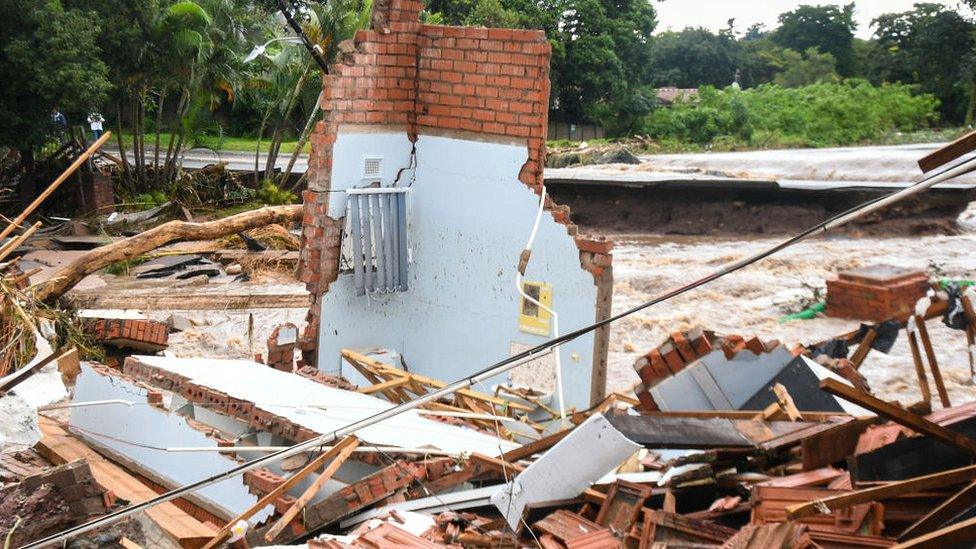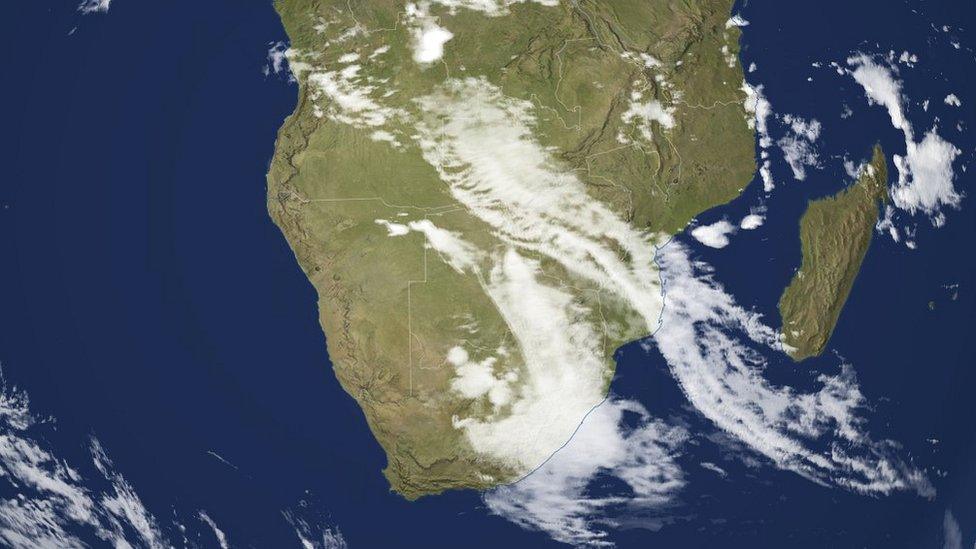Durban floods: Is it a consequence of climate change?
- Published

Houses and roads have been badly damaged in the flooding
South Africa's government has declared a state of disaster in an area in the east of the country which was hit by severe flooding over the past week, leaving hundreds dead and causing major damage.
Most of the destruction has been in the Durban area of KwaZulu-Natal province, the country's third most populous city.
President Cyril Ramaphosa claims the disaster "is part of climate change", but some locals have blamed poor infrastructure for the scale of the flooding.
What role has climate change played?
The weather system which triggered the floods led to in excess of 300mm of rainfall being dumped over a 24-hour period on 11 April.
That's a lot more than compared with previous episodes of serious flooding. In 2019, 165mm fell on 22 April and in 2017, 108mm was recorded on 10 October.
The amount of rain which fell on Monday was equal to about 75% of South Africa's average annual precipitation - and would have resulted in some form of flooding without any other contributing factors, according to experts.

A satellite image of the weather system over southern Africa on 10 April 2022
Tafadzwanashe Mabhaudhi, from the University of KwaZulu-Natal, says the weather was typical of the type that develops off the coast of South Africa, involving moisture-laden warm air moving in off the Indian Ocean.
He says the hilly terrain in that area of South Africa also means that the air rises, and as it does so, it cools and forms rain clouds.
The South African Weather Service (SAWS) said the amount of rain was "of the order of values normally associated with tropical cyclones", external.
It believes it is not correct to attribute individual weather events occurring over short timescales to longer-term trends, such as global warming.
But experts at SAWS say severe and extreme weather events are becoming more frequent and more extreme as a result of climate change.
"In other words, heavy-rain events - such as the current incident - can rightfully be expected to recur in the future and with increasing frequency," the agency says.

The flooding shifted dozens of shipping containers
A recently released report by scientists, which looked at storms in southern Africa earlier in 2022, said extreme rainfall in the region was becoming more common because of global warming.
But it added that "the precise contribution of climate change... could not be quantified, due to the absence of comprehensive historical records of rainfall".
Is poor infrastructure also to blame?
Some residents have blamed the state of local infrastructure for the disaster, citing a lack of progress in improving drainage systems, as well as strengthening roads and poorly-built housing.
Durban's mayor, Mxolisi Kaunda, has rejected suggestions the city's drainage infrastructure is to blame, but did point to the fact that some houses have been built on steep hills without solid foundations.
"One of the factors to this [disaster] is a landslide in those areas," he says.
The Durban area is hilly and dissected with gorges and rivers, and it's true that hillsides are sometimes subject to landslides.

Informal settlements have been badly hit by the flooding
But experts say that although the terrain is a contributing factor, poor urban infrastructure is also to blame.
"A combination of this rugged terrain, coupled with poor infrastructure, are factors to the flooding problem the city is experiencing," says Hope Magidimisha-Chipungu, an expert on town planning from the University of KwaZulu-Natal.
"Some of this infrastructure is old - it has surpassed its life span and needs to be replaced."
She says about a quarter of the city's population live in informal settlements - unplanned constructions which have been built on vacant land and then spread, and which are generally built with poor-quality materials.
"The materials used for building houses... fail to keep weather elements at bay, hence the collapse of houses and loss of life in some cases," she says.
Growing urban settlements
The Durban area population expanded after the end of the apartheid system in the 1990s. Before that, it was governed by racial laws that gave preference to white people.
Between 1996 and 2001, official data shows the population within the municipality increased by 2.3% over the five-year period. The rate of population growth then slowed, but the city continued to expand.
This put pressure on the existing infrastructure, which has failed to keep up.

After serious flooding in 2019, the Durban Chamber of Commerce and Industry called on the authorities to tackle infrastructure issues urgently, including carrying out "a serious review of storm water drainage systems." , external
Gina Ziervogel, an expert on climate change adaptation, from the University of Cape Town, says the authorities have been trying to address some of the challenges posed by the risks of climate change.
But she says more resources are needed, given the area's old and failing infrastructure and the new challenges posed by more extreme weather.
